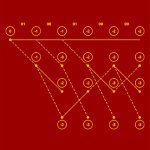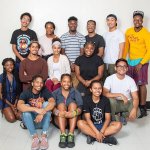115 Years, 115 Impactful Moments
Click to play USC Viterbi's 115th anniversary trivia game
 In 1905, USC offered its very first engineering courses out of the physics and mathematics departments.
In 1905, USC offered its very first engineering courses out of the physics and mathematics departments.
One hundred and fifteen years later, the USC Viterbi School of Engineering has a name and a host of accomplishments over the ensuing 11.5 decades.
This past May, Dean Yannis Yortsos, working with USC Viterbi vice deans, chairs, and select senior faculty, sought to identify 115 amazing USC Viterbi accomplishments by faculty, students and alumni over that span of time. This list would span all eight departments, the famed USC Information Sciences Institute and various programs of the school.
This list, like many of its kind, suffers from a clear recency bias. It is by no means the definitive list of all the USC Viterbi School’s noteworthy accomplishments! However, despite these limitations, perhaps it will serve as a helpful primer on what George Bekey, USC Viterbi professor emeritus, once called the school’s “remarkable trajectory.”
Test your knowledge of these USC Viterbi “wins” in a “Who Wants To be A Millionaire”-style interactive game above.
Or, for those who prefer to dive right in…the full list of 115 accomplishments for 115 years awaits.
1961-1980

The USC MESA (Mathematics Engineering, Science Achievement) Program is established in 1977.
The program is one of the nation’s most successful efforts to encourage K-12 students from minority/disadvantaged groups to consider science and technology as career paths.

In 1972, the school debuted its pioneering distance education program via the Norman Topping Instructional Television Network, or ITV. Today, that system is known as USC Viterbi’s Distance Engineering Network, or DEN (ranked No. 1 by U.S. News & World Report, as recently as 2017).
Initially, lectures were broadcast via closed-circuit television to remote sites, allowing students to interact via two-way hookup. By 2001, DEN programs are offered completely online.

In 1975, the Pre-College Programs Office was established.
Now the K-12 STEM Center, this outreach arm of USC Viterbi works to increase the number of educationally disadvantaged and underrepresented K-12 students who matriculate to four-year universities and graduate with STEM degrees.

Development of the first packet radio terminal concept is led by Tom Ellis at ISI in 1979.
A forerunner of the modern smartphone, the system proposes communicating by radio with the help of a keyboard and display screen.

In 1974, ISI develops the first portable remote-access terminal, a significant step in the evolution to laptop computers. The terminal is used by the director of the Defense Advanced Research Projects Agency (DARPA), which supports ISI and the burgeoning ARPANET.

In 1971, Keith Uncapher, who heads RAND Corporation's computing group, approaches USC about creating a computer science institute, and the Information Sciences Institute (ISI) is launched five days later.
ISI, known as USC’s “crown jewel” research institute, has been led by prolific scientists such as Herbert Schorr and Prem Natarajan, who led the expansion of ISI to Arlington, VA, and Waltham, MA, respectively, and Craig Knoblock, the current ISI Michael Keston Executive Director.

USC ISI designs an interface for ARPANET in 1972, which later becomes the basis of the internet.
Over the next several decades, ISI plays a pivotal role in creating and managing ARPANET/internet, including its core concepts, technical standards, and ongoing functionality.

Between 1963 and 1968, Dean Zohrab Kaprielian hires "The Magnificent Seven:" Solomon Golomb, Bob Scholtz, Irving Reed, Charles Weber, William Lindsey, Lloyd Welch and Bob Gagliardi.
This group of electrical engineers founded the famous USC Communications Sciences Institute in 1982.

A successful USC proposal to the Joint Services Electronics Program in 1962 helped transform USC into a major research university.
The catch was (then chair, future dean and provost) Zohrab Kaprielian did not have sufficient faculty to do the work. He took the possibility of this award to President Norman Topping and obtained authorization for 10 new faculty positions. USC’s selection was the catalyst for the two decades of dramatic growth and development that were to follow, not only in electrical engineering, but all aspects of the solid-state sciences on the campus.

In 1979, Voyager I arrives at Jupiter and begins sending back striking images thanks to basic coding by Andrew Viterbi and error coding by Irving Reed and Gus Solomon.

H.C. Andrews and William K. Pratt pioneer the JPEG compression standard, allowing images to be transmitted over the Internet. The Signal and Image Processing Institute (SIPI) is founded in 1972.

In 1967, alumnus Andrew J. Viterbi publishes a paper describing what later became known as the “Viterbi Algorithm,” the theoretical basis for worldwide cellular communication.

In 1975, USC Viterbi established the Minority Engineering Program (now the Center for Engineering Diversity).
USC thus became the first private university in California to fund a program focused on the recruitment, retention, and graduation of African American, Hispanic, and Native American students.

In 1980, John Brooks Slaughter, now a USC Viterbi professor, became the first African American director of the National Science Foundation.
His distinguished career has included service as chancellor of the University of Maryland College Park and 11 years as president of Occidental College where he helped shape the college’s current mission and make it one of the most diverse liberal arts colleges in the country.

In 1970, the same year that the Nixon administration created the Environmental Protection Agency (EPA), USC Engineering lauched the Environmental Engineering Program, among the first programs of its type in the country

In 1961, the Olin Foundation gifted $2.3 million to USC for construction of Olin Hall, the first major gift in USC's $106-million fundraising campaign.
Under the leadership of dean Alfred C. Ingersoll, this partnership continued with Vivian Hall of Engineering and Materials Science in 1967 — constructed with another $2.7 million grant from the Olin Foundation.

Equipped with the ability to adapt to arbitrary shapes without any external control, pioneering roboticist George Bekey co-created the world’s first five-fingered robot in 1977—the first able to give a true handshake.

In 1977, Leonard Adleman helped invent the RSA cryptography system, the world’s most widely used public-key cryptography method for securing communication on the internet, which earned him the famed Turing Award.

In 1976, USC established the Department of Biomedical Engineering, the first such program in the state to offer bachelor, master and Ph.D. degrees.

Twelve USC Viterbi alumni have journeyed beyond Earth’s atmosphere as NASA astronauts.
These include: Charlie Bolden, former NASA administrator, who flew on four space shuttle missions; and Nancy Currie-Gregg, who flew in four space shuttle missions, accruing 1,000 hours in space. In addition, Professor Garett Reisman spent 95 days aboard the International Space Station after which he returned to Earth aboard the Space Shuttle Discovery in 2008. Professor Paul Ronney, now AME department chair, was selected as an alternate payload specialist astronaut. His experiments flew on two Columbia Space Shuttle missions in 1997 (the mission he was backup for) and one in 2003.

In 1974, Fred Browand published the classic paper that builds on work by Richard Kaplan and Ron Blackwelder on how to reduce air drag on vehicles, research that continues to influence vehicle design to this day.
Cited 1400 times, it was the first to show experimentally that two or more vortices in fluid flows have tendency to merge to form larger vortices. This concept continues to be utilized today to control the growth of the shear layers, reduce noise from jets and control the mixing within shear layers.

In 1964 Janos (John) Laufer, left the Jet Propulsion Laboratory to found and chair the USC Viterbi Department of Aerospace Engineering.
Laufer was renowned for his work in fluid mechanics and died in 1983.

In 1964, Norman Schwarzkopf, future commander of Allied forces in the 1991 Gulf War, earned his master of science degree in mechanical engineering at USC.
Schwarzkopf was a highly decorated soldier who demonstrated notable leadership in the Vietnam War; in addition, he planned and led Operation Desert Storm as part of the Gulf War.

In 1976, USC Viterbi professors Tony Maxworthy and Larry Redekopp published a paper in Nature explaining Jupiter’s Great Red Spot as a solitary wave in the Jovian Atmosphere.
Maxworthy and Redekopp were long-time collaborators in the Department of Aerospace and Mechanical Engineering, largely focusing on fluid mechanics, from the microscale processes in jets to the macroscale of oceans and atmospheres in space.

In 1970, Neil Armstrong, who was the first person to step foot on the moon during the 1969 NASA Apollo mission, graduated from USC with a master of science degree in aerospace engineering.



